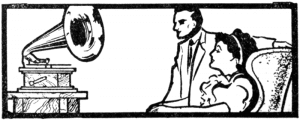 Music is everywhere. Our commercials, online ad spots, in our radios, courtyards, arenas, phones, record players, mp3 players, CD players, even our wax cylinders and greeting cards. We are saturated with it, and chances are, your world probably is too.
Music is everywhere. Our commercials, online ad spots, in our radios, courtyards, arenas, phones, record players, mp3 players, CD players, even our wax cylinders and greeting cards. We are saturated with it, and chances are, your world probably is too.
Part 4, When Your World Mirrors Ours
If your homebrew is an Austen-era fantasy of manners or a near-future gritty cyberpunk, the music to write, read, and play to is just a few clicks away. For a world that focuses sharply on Georgian and Regency England, you’d be moving through music across the Baroque, Classical, and Romantic eras. If you’re looking at the years 1714-1820, it’s an understatement to say a lot was happening the world over. Does your world fall firmly in Romantic-era Germany? Erlkönig, Schubert’s musical throne for Goethe’s poem of the same name should go on your to-listen list. Music says a lot about us and our culture in the moment it’s conceived. Just using Baroque, Classical, and Romantic, you can see sharp sections of inspiration and fierce pushback between these eras as aspects of theater are seen as too, well, baroque, or too sparse, etc. While from the top down, a lot of what we talk about as “highbrow” art is consistently inaccessible to most in middle or lower incomes, these musical works filter out, into dance halls, sketchy theaters, into places we don’t call highbrow. Opera can become pop music in these circumstances, albeit with much modified (or entirely new) lyrics in these places. Popular music of the time may be used to tell bawdy spins on Greek tragedy. Music is an art form that is difficult to control.
 Should your world mirror ours but with extreme historic change, that will change the music in your world. Is Queen Victoria successfully assassinated only a few years into her reign? Do the Crusades end early? Or never happen? Who discovers the heliocentric universe, atomic science, germ theory? Your world’s music can turn on a pin of historic changes, great or small.
Should your world mirror ours but with extreme historic change, that will change the music in your world. Is Queen Victoria successfully assassinated only a few years into her reign? Do the Crusades end early? Or never happen? Who discovers the heliocentric universe, atomic science, germ theory? Your world’s music can turn on a pin of historic changes, great or small.
Near-world homebrews, where cyberpunk technologies we don’t have yet and the mind-numbing entertainment exploits once confined to the pages of Fahrenheit 451 come out to play don’t play as heavily on themes of musical separation in the same way as past eras. There’s still separations by type of person and music (some men who are fans of female pop singers may not feel comfortable going to their concerts, into a space seen as feminine), by financial difference (music festivals quickly outstrip their original audience in terms of scope, size, corporate participation, and subsequent price hikes), and via the digital divide (not everyone has ready access to digital devices, that access may be uneven in terms of generation of device, where they get their music, etc). In near-world, present or 10 minutes in the future settings, we’re familiar with how divides of demographic influence consumption, the music we seek out, and how we encounter music.
While the blanket of “techno” lies over all music we hear in cyberpunk movies and television, that description is like “classical music” or “Kleenex.” It’s used to represent its original object (techno genre, the classical era, Kleenex brand tissues) and wraps up everything possible that it can in its arms and squeezes them to death. We say “techno,” but we could be more specific by saying electronic music, which is a general purpose descriptor that isn’t erroneous. If you cut your teeth on MuchMusic growing up, your idea of what electronic music sounds like will be different from someone in the States fumbling through Napster. As you look for music genres that convey your world, keep your eye on how it changes, influences and changes across cities, countries, globally. In a digital age, our music can change in moments. If your players are, say, mercenaries freeing a pop star from their contract because they want to go darkwave and the label will straight up ice them, genre/subgenre differences matter.
Many of us have a sort of scene (or scenes) in our heads of cyberpunk worlds. Mass transit. Sketchy (maybe floating) cabs. Neon and holo everything. Looking for information in a night club. Hacking computers. Hacking phones. A kidnapping from a rave. Falling in love at a luminescent pop concert. That sense of place and world is often built primarily in visuals, but the music matters too. As a creator, it gives you something to follow, like a neon logline. That music will be useful for your players as well, an EDM thread to follow through the labyrinth of your world.
Stars Beyond Our Own
But not every homebrew world does (or should) share our reality. Instead of considering how mundane or preternatural changes shape your world’s music, major and minor can be meters for you to toggle. Music in major key is familiar to many of us. It’s the scales of Western music, it may sound “bright” to us, and minor key may sound “dark.” When a “happy” song sounds sad, creepy, or downright gothic in a cover, you’re likely listening to major-key music being covered in minor key. The reverse can be done, taking “sad” songs and making them “happy.” In a world you’re building from scratch, ask yourself if those keys would serve you well as you write. Is this a place where Western scales make sense and major or minor conveys a sense of mood and embodies what this place is like? Is it, like the covers example, a place where beauty is expressed with sinister overtones, or is it a place where joyful music hides terror?
For even more insights on on how to run your game, check out the many wonderful voices in Kobold Guide to Gamemastering.
